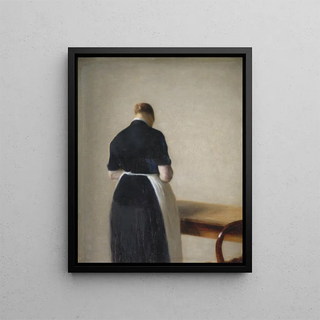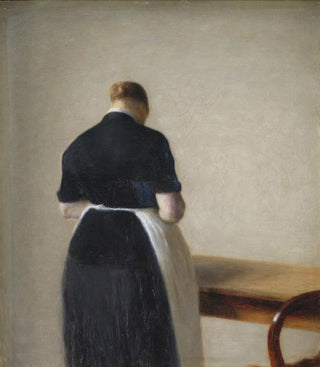Art print | Woman seen from behind - Vilhelm Hammershøi


View from behind

Frame (optional)
In the delicate universe of Danish painting, the art print "Femme vue de dos" by Vilhelm Hammershøi stands out for its ability to capture the intimacy of a suspended moment. This painting, imbued with melancholy and poetry, invites us to immerse ourselves in a space where time seems to stand still. The silhouette of a woman, elegantly turned towards a soft light, evokes an atmosphere of serenity and contemplation. Through his choice of composition and palette, Hammershøi manages to transform a simple gesture into a true ode to the silent beauty of everyday life. This work, in its very essence, reminds us that art can be a mirror of our deepest emotions.
Style and uniqueness of the work
Vilhelm Hammershøi's style is characterized by a unique approach to realism, blended with impressionist sensitivity. In "Femme vue de dos," the clean lines and simple forms combine to create an atmosphere of intimacy. Light plays a central role in this composition, flooding the space with an almost tangible softness. The shades of gray and beige, typical of his work, reinforce the idea of a scene that is both ordinary and extraordinary. Every detail, from the delicate movement of the woman's dress to the texture of the walls, is carefully thought out to evoke a sense of calm and reflection. Hammershøi thus succeeds in transforming a mundane moment into a rich and emotive aesthetic experience.
The artist and his influence
Vilhelm Hammershøi, an emblematic figure of the Danish artistic movement, managed to mark his era with a singular vision of art. Born in 1864, he was influenced by the great masters of European painting, while developing a style that is uniquely his own. His work is part of a dialogue between modernity and tradition, seeking to express universal feelings through intimate scenes. Hammershøi was also a pioneer in the use of light and space, prefiguring later artistic movements such as minimalism. His ability to evoke complex emotions through simple compositions has made him an essential figure in art history.

Matte finish

View from behind

Frame (optional)
In the delicate universe of Danish painting, the art print "Femme vue de dos" by Vilhelm Hammershøi stands out for its ability to capture the intimacy of a suspended moment. This painting, imbued with melancholy and poetry, invites us to immerse ourselves in a space where time seems to stand still. The silhouette of a woman, elegantly turned towards a soft light, evokes an atmosphere of serenity and contemplation. Through his choice of composition and palette, Hammershøi manages to transform a simple gesture into a true ode to the silent beauty of everyday life. This work, in its very essence, reminds us that art can be a mirror of our deepest emotions.
Style and uniqueness of the work
Vilhelm Hammershøi's style is characterized by a unique approach to realism, blended with impressionist sensitivity. In "Femme vue de dos," the clean lines and simple forms combine to create an atmosphere of intimacy. Light plays a central role in this composition, flooding the space with an almost tangible softness. The shades of gray and beige, typical of his work, reinforce the idea of a scene that is both ordinary and extraordinary. Every detail, from the delicate movement of the woman's dress to the texture of the walls, is carefully thought out to evoke a sense of calm and reflection. Hammershøi thus succeeds in transforming a mundane moment into a rich and emotive aesthetic experience.
The artist and his influence
Vilhelm Hammershøi, an emblematic figure of the Danish artistic movement, managed to mark his era with a singular vision of art. Born in 1864, he was influenced by the great masters of European painting, while developing a style that is uniquely his own. His work is part of a dialogue between modernity and tradition, seeking to express universal feelings through intimate scenes. Hammershøi was also a pioneer in the use of light and space, prefiguring later artistic movements such as minimalism. His ability to evoke complex emotions through simple compositions has made him an essential figure in art history.






